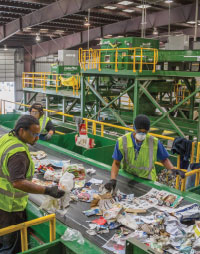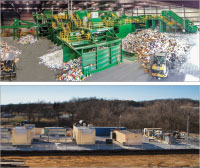American Waste Control has combined its material recovery facility with waste-to-energy technology to maximize recycling and provide power to thousands of Oklahomans.
 It seems like a Catch-22. A local waste company is a critical part of the sustainability of any community big or small, and yet, few really think of waste industry professionals as pioneers when it comes to ecofriendly innovations.
It seems like a Catch-22. A local waste company is a critical part of the sustainability of any community big or small, and yet, few really think of waste industry professionals as pioneers when it comes to ecofriendly innovations.
Luckily, that view is changing as fast as an Oklahoma windstorm. Waste services companies are not only becoming known for their cleanliness and environmental practices, but they are actually stretching the frontiers of sustainable technology.
Case in point: The Mr. Murph Waste-to-Energy (WTE) program at American Waste Control (AWC).
By national standards, AWC is only a small to mid-sized waste management company. Its headquarters are little more than a stone’s throw from downtown Tulsa—the former oil capital of the world—but, AWC’s efforts for providing a new renewable source of energy are making a small part of history here.
For some time now, AWC’s goal has been to divert reusable resources from the waste stream through its Mr. Murph recycling program and then utilize the waste material that cannot be recycled to produce a new energy source to power homes.
The results, so far, have been groundbreaking as AWC has built up its infrastructure and invested millions into new sustainable technology. AWC has recycled more than any other waste company in the city of Tulsa, and it has just begun providing a new clean energy source that could help spur a movement of energy innovation statewide.
The making of Mr. Murph
AWC actually started recycling in 1987, back before any sort of high-tech machinery really caught on. It called its method “kickin’ and pickin’,” which simply means pulling cardboard manually out of the piles of trash delivered to its transfer station. As the years went on, AWC wanted to make an even bigger impact, so by 2011, it began the process of designing and building its own material recovery facility (MRF) (or Mr. Murph, as the company refers to it), which was the first licensed MRF in Oklahoma.
The $10 million upgrade converted the existing facility to fully automated processing of mixed recyclables, allowing for easier recycling and the collection of a wider variety of waste material such as cardboard, paper, aluminum, steel, plastic and glass.
AWC spent approximately one year in design planning and six months in the actual installation process of Mr. Murph, which included numerous site and design revisions. The prep time in planning paid off for AWC, as the company was able to implement design features that added significant efficiencies to the facility. A good example is the redundant functions built into the MRF to increase uptime in case of any technical delay or malfunction.
Mr. Murph replaces an almost entirely manual process with dozens of screens, magnets, optical sorters, air classifiers and quality control inspection points to dramatically improve the separation and marketing of the recyclables AWC collects.
The facility accepts single-stream recyclable materials from businesses and approximately 130,000 single-family residences throughout Tulsa, as part of a 10-year contract the company signed with the city in October 2012.
Mr. Murph also is fed via a one-cart system from neighboring communities, as well as some commercial?customers, with bagged trash and?loose recyclables in the same?container. AWC has also set out more than 100 Mr. Murph recycling bins around the city to facilitate broad-based citywide recycling.
AWC believes it is having a huge impact, considering that every bale of recycled cardboard AWC processes is the equivalent of 17 trees, 7,000 gallons of water, 390 gallons of oil, or 4100 kilowatt (kW) hours. That adds up over time as the efficiency gained by the automated equipment greatly reduces the impact of trash on the environment and decreases the use of natural resources in the manufacturing process of new products.
AWC can now divert a large percentage of reusable trash away from the waste stream, which is a huge environmental plus. That is a direct result of its investment in its MRF.
 Since going to a fully automated system, the material recovery rates from single-stream recyclables delivered to the MRF are now as high as 95 percent of the recyclables processed. Prior to automation, AWC says its recovery rates were 20-30 percent. The city of Tulsa now has a 22 percent diversion of recyclables from the waste stream, which represents a dramatic shift in trash disposal efficiency.
Since going to a fully automated system, the material recovery rates from single-stream recyclables delivered to the MRF are now as high as 95 percent of the recyclables processed. Prior to automation, AWC says its recovery rates were 20-30 percent. The city of Tulsa now has a 22 percent diversion of recyclables from the waste stream, which represents a dramatic shift in trash disposal efficiency.
With Mr. Murph, AWC can now process and reclaim almost 200 tons of recyclables per day. A modest sum to many, especially compared with other larger national chains that are able to process many times that amount. But for a company of AWC’s size and scope, it’s historic.
Finding a way to reduce a growing percentage of the city’s waste has always been AWC’s goal and now it’s a reality. The company says it believes its recycling facility to be the cornerstone for a unique sustainability potential: its innovation is reducing waste and providing a new source of power that could potentially transform the overall energy usage in AWC’s neck of the woods.
The lights come on
When AWC designed and built its MRF in 2011, it was clear to company officials that they were only in the initial stages of realizing even greater sustainability as a company and a community. They knew they still needed a way to make use of the small percentage of material waste that could not be recycled.
With this in mind, AWC began implementing an innovative approach for using nonrecyclable trash residue at its landfill to produce renewable energy and power homes. Its system, which was designed and installed by Pittsburgh-based Montauk Energy, relies on methane-rich landfill gas made by decomposing garbage at the landfill.
Landfill gas is about 50 percent methane, the primary component of natural gas. AWC is now piping that methane into a processing and generation plant under a contract with Montauk Energy. The electricity then flows to the Oklahoma Municipal Power Authority, which supplies power to nearly 4,800 homes in Pawhuska and 38 other small Oklahoma communities.
Prior to 2012, AWC had been flaring off the methane, which is the usual method of dealing with the potent gas. Although flaring keeps it from entering the atmosphere, where it can hurt the ozone, it also wastes a potential rich energy source. If it is not captured, according to the U.S. Environmental Protection Agency, landfill methane has the potential of becoming 20 times more potent than carbon dioxide, a chief greenhouse gas.
By converting thousands of tons of trash per day into energy, AWC’s WTE project is helping protect the region’s air and water quality from increased carbon emissions. The company also is adding on decades of life to its roughly 220 acres of permitted landfill space.
All this adds up to a huge environmental plus for the Sooner State that could have significant ramifications.
Not only does AWC generate electricity, but it is offsetting fossil fuel consumption and reducing greenhouse gas to create an incredible energy resource. The net result is improved lives as it utilizes a technology that is the first of its kind in the hub of Oklahoma’s oil country. As a local, Tulsa-based waste company, AWC says it couldn’t be prouder.
It’s not just ecofriendly. It’s smart. And, it’s paving a way for sustainability that could pay dividends for Oklahoma’s energy future.
Paul Ross is general manager of American Waste Control’s family of companies.
